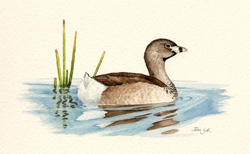Breeding Bird Atlases (BBA)
Find a Bird - BBA1
Breeding Bird Atlas 1 Species Accounts
Pied-billed Grebe
Podilymbus podiceps
State Status
Endangered
Egg Dates
April 23 to July 3
Number of Broods
one; may re-lay if first attempt fails.

Like most marsh-nesting species, the Pied-billed Grebe has declined drastically during this century. It is now a rare and local breeder, with Atlas confirmations only at coastal locations. Historically, Pied-billed Grebes were not known to nest along the coastal plain or on the Islands, but the construction of freshwater impoundments at Parker River and Monomoy national wildlife refuges may have contributed to this change. There were no proven nesting records from the Sudbury River valley, which was formerly a stronghold for the species. Post-Atlas breeding has definitely occurred at three sites in Worcester County.
Resident Pied-billed Grebes appear in March shortly after ice has melted on ponds, and the few migrants that occur have generally departed by the end of April. Residents begin nesting activities in April or May. Preferred habitats have stands of cattails and other emergent vegetation adjacent to areas of open water. Grebes may be difficult to locate in these marshes, but the cuckoolike series of cuck and cow notes is a sure sign of their presence. Foods include fish, insects, snails, seeds, and soft plants.
Both sexes construct the nest, a well-concealed platform of dead marsh vegetation situated in water 1 to 3 feet in depth and anchored to living plant stalks. The usual clutch of four to seven eggs is incubated, mostly by the female, for slightly more than three weeks. Eggs are covered with nest material whenever the adult leaves them unattended. The distinctively marked black-and-white striped young can swim and make shallow dives soon after hatching. They are often transported on the backs of the adults, loosely held in place by the adult’s wings. The parents carry bits of food to the young chicks. Juveniles approach adult size before losing the striped plumage.
A very complete nesting chronology for this species in Massachusetts was recorded in Worcester after the Atlas period. One adult, probably the male, arrived on March 4 but was not paired until April 3. Nesting activity commenced on April 16, and the female was incubating by the end of the month. The two young hatched about May 21 and were accompanied by at least one adult through June 13. An independent juvenile was last seen on June 19 (Babbitt). Additional brood records range from May 31 to July 23 (BOEM). Although the Pied-billed Grebe may rear two broods in some parts of its range, there is no evidence that this occurs in Massachusetts.
Fall migrants are present from mid-September to November. Most occur singly, but loose groups are observed at times on lakes, reservoirs, or rivers. Pied-billed Grebes are rarely encountered on salt water. Most individuals move farther south as winter approaches, but a few overwinter in places where the water remains open.
The Pied-billed Grebe is listed as a threatened species in Massachusetts.
Map Legend and Data Summary
Atlas 1 data collected from 1975-1979


Note: rare and local in freshwater marshes; declining
Allen H. Morgan, Richard A. Forster, and W. Roger Meservey



